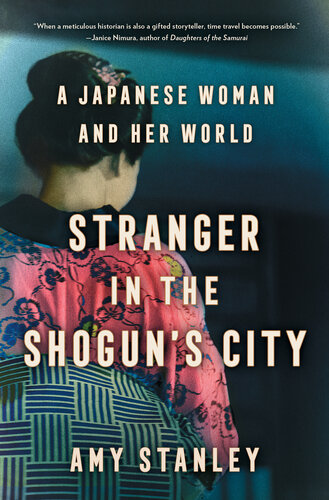
Stranger in the Shogun's City
A Japanese Woman and Her World
- اطلاعات
- نقد و بررسی
- دیدگاه کاربران
نقد و بررسی

May 4, 2020
Northwestern University history professor Stanley debuts with an evocative and deeply researched portrait of 19th-century Japan through the events of one woman’s life in the decades before Commodore Perry’s 1853 arrival and the opening of the country to the West. Drawing from a collection of family papers, Stanley recreates the life of Tsuneno, “the loudest, the most passionate” daughter of a Buddhist priest, from her birth in a farming village in 1804; to her first marriage, at age 12; her long-awaited departure for Edo (present-day Tokyo) in her late 30s; her fourth and final marriage, to an unsteady samurai; and her death in 1853. Stanley documents numerous misfortunes endured by Tsuneno, including being raped by the man who escorted her over the mountains to Edo, being forced to take menial jobs, and wearing one unlined robe for months as her angry brother refused to ship her clothes to her. And yet, Stanley argues, “wise, brilliant, skillful” Tsuneno “always claimed what was hers.” Stanley fills in the blanks of Tsuneno’s letters and diary entries with well-informed speculation about her daily life and atmospheric descriptions of corrupt and sophisticated Edo during the Tokugawa shogunate. Japanophiles and readers of women’s history will be entranced. Agent: Jill Kneerim and Lucy Cleland, Kneerim & Williams.

May 15, 2020
One woman's life reveals society and culture in 19th-century Japan. Historian Stanley brings a deep knowledge of Japanese culture to a vibrant portrait of the Asian nation centered on the struggles of one defiant woman. Tsuneno was born into a respected family--her father was head priest in a temple of the True Pure Land sect--in a rural province, two weeks' walk from the capital, Edo. As Tsuneno grew up, going to school and learning the skills--needlework, especially--that she would need when she married, she heard enticing talk about Edo, which beckoned as a place of "fashion and sophistication." Though she dreamed of seeing it, her life took a different direction: When she was 12, she was married to a True Land priest in another province, even farther from the capital and far from her home. Although it was customary to wait until a girl was 14 before consummating the marriage, Tsuneno became integrated into her new family and, in time, her role as a wife. Fifteen years later, though, her husband filed for divorce, for reasons that Stanley can only guess at. The marriage was childless, and Tsuneno returned to her family. A year later, her family found her another husband, but that marriage lasted only four years; another match was made for the 34-year-old Tsuneno, but this one endured "four blurry, claustrophobic months." After three failed marriages, Tsuneno decided to direct her own fate: She would finally leave home and travel, on foot, to Edo. Stanley creates a palpable sense of the Japanese capital: a teeming, highly stratified city where newcomers faced poverty and discrimination, migrants lived in hovels, and the only jobs available to Tsuneno--if she was lucky--were in service to a shogun or samurai. Despite hunger, cold, illness, and betrayal, she persisted, determined to achieve the independence she desperately desired. An absorbing history of a vanished world.
COPYRIGHT(2020) Kirkus Reviews, ALL RIGHTS RESERVED.

May 15, 2020
Tsuneno belongs to a vanished world, but historian Stanley brings both her and the Japanese city of Edo back to life in this breathtaking work. Born to a temple family in a remote, snowbound village at the beginning of the nineteenth century, Tsuneno came to Edo after a series of three marriages, the first when she was 12 and after surviving a yearslong famine. Her stubborn spirit would be needed to face the trials that awaited her in Edo, the seat of power in a country that was largely closed to the outside world. Vividly recounted in letters are her struggles to find her way and make peace with her family. While she was there, Edo was transformed from the glamorous metropolis the village girl had dreamed of to a city besieged by stringent moral reforms. Even as the reforms lifted, underlying issues remained, and a short time after Tsuneno's death, her city fell to an uprising, to be reborn as Tokyo. This is an eye-opening account of an extraordinary ordinary life.Women in Focus: The 19th in 2020(Reprinted with permission of Booklist, copyright 2020, American Library Association.)

September 4, 2020
Stanley (history, Northwestern Univ.; Selling Women: Prostitution, Markets, and the Household in Early Modern Japan) offers a look into the lives of ordinary people living in early 19th-century Japan. The bulk of the story follows the life of Tsuneno, the daughter of a Buddhist priest raised in rural Echigo Province (modern day Niigata Prefecture) on the snowy western coast. Although not from the upper echelons of society, being the daughter of a priest meant that Tsuneno and her family were literate. The writings they left behind allow present-day readers to learn much about their lives. After three failed marriages, thirtysomething Tsuneno ran away from home to pursue a new life in the big city of Edo (modern day Tokyo). Throughout the retelling of her life story, readers will discover the lives of Japanese temple families, farmers, big-city samurai, and more. Stanley's historical narrative of people and place helpfully puts Tsueno's life within the context of larger national and international events impacting Japan at the time. VERDICT Essential for anyone interested in 19th-century Japanese history, and a great companion piece to Anna Sherman's The Bells of Old Tokyo, which compares modern day Tokyo with historic Edo.--Joshua Wallace, Tarleton State Univ. Lib. Stephenville, TX
Copyright 2020 Library Journal, LLC Used with permission.




دیدگاه کاربران